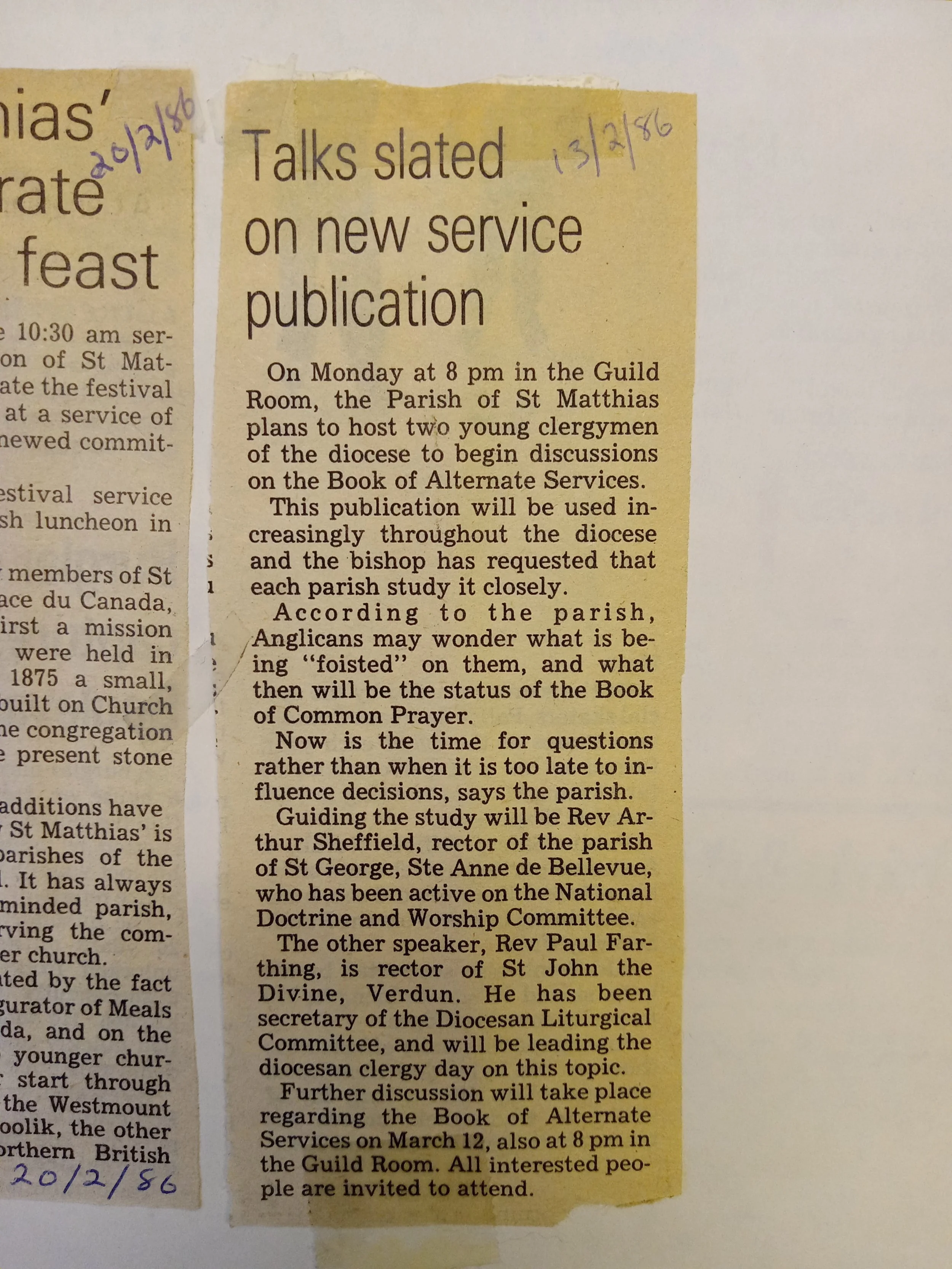May 7th: Anniversaries Part Two
St. Matthias’ was officially founded as a mission of St. George’s, Place du Canada, in 1873, which means our community is 150 this year! For the next 12 months, we’ll be diving into the archives to shine the spotlight on particularly interesting parts of our history. This is the first of a multi-part series on anniversary services at St. Matthias’. This week, we cover the first service in the new building and the celebration of the building’s 50th anniversary.
The front cover of the bulletin for the 75th anniversary of the new building in April 1987.
What’s in a bulletin? This week’s snippet from our archives zooms in on the bulletin from the 75th building anniversary to uncover the ways in which a single small document can carry within it quite a large number of stories. As the bulletin with the most non-liturgical information (aside from the 100th parish anniversary bulletin from 1973), this rich source gives us a peek into the currents beneath the surface in the St. Matthias’ of the late 1980s. Whether you’re interested in underhanded compliments, tireless People’s Wardens, financial woes, or liturgies for children, read on to discover the portrait the bulletin paints of St. Matthias’!
Clergy
As in many bulletins intended to be keepsakes, this one includes tributes to the St. Matthias’ building from the sitting Bishop of Montreal, from an interim pastor who was also a bishop, and from a past rector. All three tell us something important about the state of the church at the time! Let’s begin with the past rector, who was asked for the second time to contribute remarks despite not being the incumbent (read about his 50th anniversary bulletin remarks here).
For the second time in less than five years, St. Matthias’ had found itself rector-less, as Rev. Randolph Wood, who had been inducted in 1984 following Archdeacon Jack Doidge’s retirement the previous year, left suddenly in November 1986. A month previous, the curate, Rev. Cedric Cobb, had been transferred to Ste. Agathe, and although a selection committee was struck at a Special Vestry at the end of November, the new incumbent, Rev. Paul James, would not arrive at St. Matthias’ until June 1987. Archdeacon Doidge graciously wrote a note for the anniversary bulletin, but the absence of a rector is palpable in its pages. For those “in the know,” the final page of the bulletin is most telling in this respect: Raymond Ullyatt contributed a brief history of the church, but, as Vestry minutes and various reports attest, he spent most of his nearly four-year tenure as People’s Warden effectively running a rector-less church. He was replaced as People’s Warden by Sandra Cameron at Vestry 1987, but would continue to be involved in leadership – notably, financial – for some time to come.
In the absence of an incumbent, St. Matthias’ followed a familiar pattern of visiting presiders, including the regional dean, Rev. Stephen Eardley, who took the Mattins services on the anniversary, and Bishop James MacLean, who had moved on from being the Archdeacon of St. Andrew’s in Montreal the year before Archdeacon Doidge retired. Bishop MacLean wrote a tribute to the steadfastness of the “strong hulky building” for the bulletin, but in a turn of events illustrative of this particular season in the life of the parish, even this interim pastor would not be present for the anniversary.
One last episcopal note deserves some attention: Bishop Reginald Hollis, the sitting Bishop of Montreal, wrote a tribute that now, nearly forty years later, reads as somewhat lacking, at least in comparison to the other bulletin messages. Bishop Hollis begins by assuring Matthians that although some people dismiss them as simply wealthy, he knows that they have the same needs “for love and forgiveness” as any other people. His compliments to the building are really about church buildings in general, until the last line, when he remarks that our “solid looking building” is proof that “we are not caught up in the latest ideas.” He looks forward to “a time of challenge for the church” and prays that St. Matthias’ bear “a realistic witness.” But what kind of challenges might this old-fashioned parish, searching for meaning, have needed to approach realistically?
Money
Throughout its history, St. Matthias’ has struggled with money. Despite the reputation for affluence Bishop Hollis pointed out, as far back as our records go we have had issues making ends meet. 1987 was no exception: even though the Wardens’ Report to Vestry 1988 recalled that the absence of clergy was actually good news for church finances, the 1987 budget shows a significant deficit. Following the pattern established earlier in the 1980s, the budget included withdrawals from the Memorial Fund to cover a deficit of nearly $37,000 ($85,000 in today’s dollars). Nevertheless, 1987 saw expenditures in stained glass restoration and repair that would continue into the 1990s, the commissioning of a new sketch of the building by Susan Heller for the anniversary (visible on the bulletin cover), and choir honoraria. Some of these costs were offset by targeted fundraising, especially from the families of those who had donated stained glass, but we can see in the 1987 actuals that these targets produced less than 25% of the revenue required to offset what Bishop Hollis might have thought less-than-realistic costs.
A smaller financial point is in the bulletin’s cooption of a $75 bicycle ($175 today). The Adult Education Committee, in their section of the 1987 Annual Report, tells the same story of motivation as the bulletin does, with one crucial difference: the committee were not thinking of the 75th anniversary, nor, indeed, of the whole church. Why, then, this retrospective attribution of the gift to anniversary generosity? The compilers of the bulletin left no explanatory notes, but given that previous anniversaries, as Ullyatt notes in his historical remarks, featured significant gifts, it is possible that there was a sense of the need to follow precedent. Certainly, for a church undergoing as much change as St. Matthias’ was throughout the 1980s, holding on to a self-image like this may have been quite important.
Liturgy
Because the church was also undergoing liturgical change in the latter half of the decade, with the introduction of the Book of Alternative Services. St. Matthias’ had begun hosting 9am BAS services in September 1986, which the Wardens’ Report to Vestry in early 1987 describes as surprisingly successful. Other reports to that Vestry make it clear that the BAS services, which replaced Sunday School in the fall and took place not at the main altar but in the transept space (which the Chancel Guild thought in need of a serious décor update!), were not seen as services for the whole parish, but instead were understood as services for children. The main St. Matthias’ service continued to use the Book of Common Prayer.
The BAS rollout was controversial across the Diocese; St. Matthias’ adoption in September was prefaced by a presentation in February from Rev. Arthur Sheffield, whose parish of St. George’s in Ste-Anne-de-Bellevue had been the site for experimental trials leading up to the rollout. Your humble historian’s father was a parishioner at St. George’s during this period and has attested to a general feeling that the BAS was a set of liturgies perfectly designed to cause as little serious stir as possible, which is perhaps what resulted in this general sense at St. Matthias’ that the BAS was for children.
These are the kinds of documents that our archives contain, where a single bulletin can open up several years’ worth of stories! Certainly, the ones lurking beneath the 75th anniversary of the new building’s surface are best enjoyed, as after the 11am service that 26th of April, with a glass of sherry and a thick slice of cake.
















